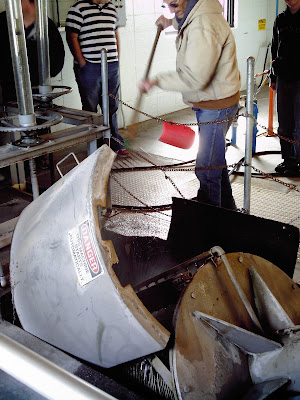My friends Rebekah and Scott get to go on field trips to collect fossils. I’m jealous; I should have taken paleontology. Instead I took hydrology, so I got to go on a field trip to the Wastewater Treatment Plant here in Rexburg, which actually was fun, too. This is the place where they take the water that came from all the toilets in Rexburg and a couple neighboring towns (as well as other waste) and turn it into fertilizer and drinking water. The place smelled like… and the guy that was supposed to give us the tour wasn’t there so we got the bargain tour. This meant we would go into a room, hear him say “this is where we check the water for metals,” and then go to the next place where you “monkey with these valves over here to control where the sludge goes.” Fortunately, we learned more afterwards, so you get, not a better tour since it’s just my photos, but a better explanation. So sit back and hold your nose.

And end up in this bin:

The liquid moves on, and is moved to the Willy Wonka Chocolate River:





Here, bacteria are added to break down the organic waste in the water. These channels are 20 feet deep, and constantly churned so they can be aerated. This allows more oxygen into the system, which assists the biological agents digest their delicious meal (which used to be your delicious meal). Sadly, I don’t have a picture of this; but it is at this point (according to our guide) that the corn (not kidding) floats to the top and is eaten by ducks. If you fall in (like someone did the other day, apparently), don’t worry because there are life preservers to save you:

This is particularly good news, because if you die from drowning in poo, you don’t get to go to Heaven because you’d smell really bad.

As new chocolatey water enters the system, processed water leaves, diverted by these valves:

The processed water enters these “clarifiers” (also known as sedimentation tanks):


Inside, the water is still. The heavy “stuff” sinks to the bottom and is scraped into a hopper at the bottom. The light stuff floats to the top and is skimmed off by these:


It’s not entirely clear on the picture, but that’s moss growing on the skimmer; human waste is very rich in nutrients. The material that is removed becomes sludge, and is treated separately. It moves through these pipes:

Then is processed on these conveyor belts (notice the piece of sludge):

As it moves across the belt, it is agitated to increase the surface area as chemicals are added to thicken the sludge. Then it can be made into fertilizer and sold to farmers. It is loaded into a hopper and then onto a truck (notice the splatter):


The water is filtered, then tested for heavy metals (sorry, no pictures of that room). Once it is clean, it is discharged back into the river, and is cleaner than what comes out of your tap. All along the way there are hazards:


And after you’ve seen all this, you smell like human waste and feel like it’s in a layer all over you and in your throat. Fun!
2 comments:
Um.....I'm going to hurl. real bad......
BLECH! Paleo is WAY better!
It was a fun field trip, but yes, I agree that you got the good field trip. Even with the ice and snow, at least you got to bring home ammonoids, and not something you probably helped to make.
Post a Comment